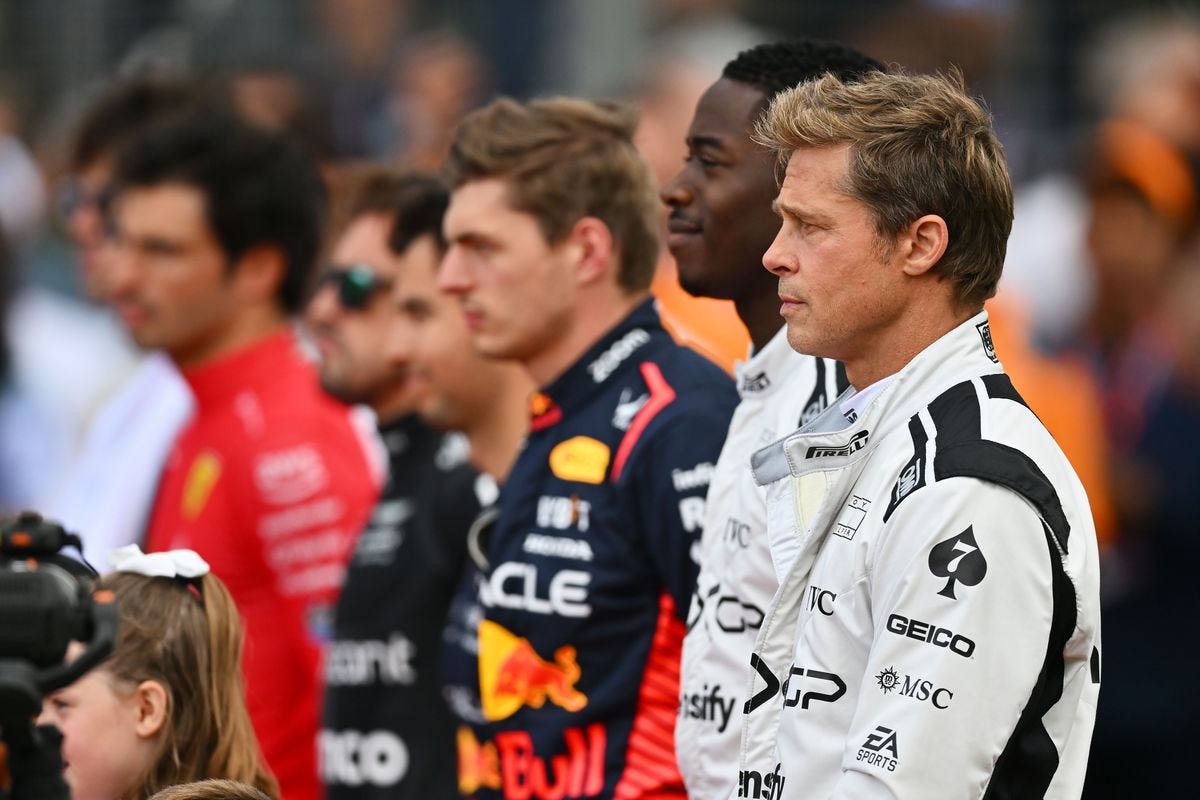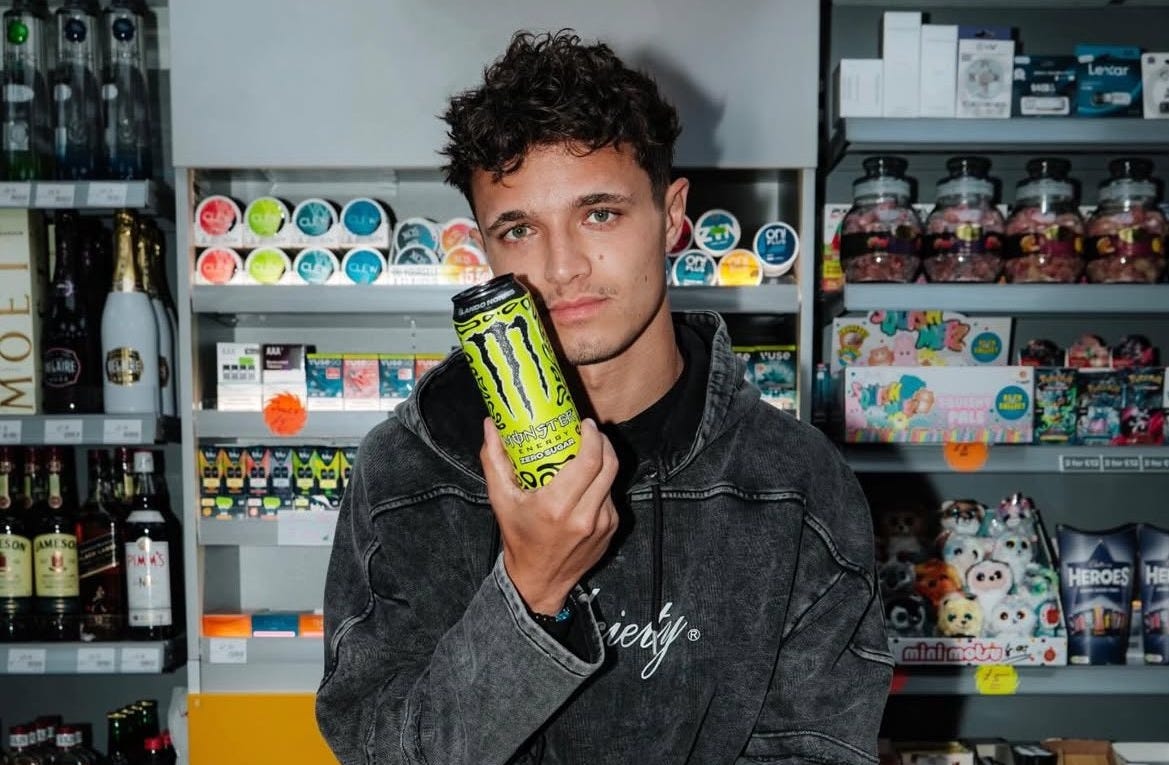Formula 1 Prepares for a Second Popularity Surge Following “F1”
Plus: Lando Norris’ radioactive energy drink, motorsport summers are getting hotter and smokier, Verstappen backs Vettel and another FIA exec leaves.
Welcome to The Undercut, a weekly newsletter round-up of the top storylines in racing brought to you by your favorite motorsport and enviro journo, Olivia Hicks. If you’re wondering “What the f*** is Formula 1?” Ask away! Leave a comment or send me a message with your burning questions.
After taking a break for a couple of weeks, I’m back with a round-up of the top stories in F1.
Formula 1 Prepares For a Second Wave Following “F1” Release
When Hollywood caught wind of a speedy, globe-trotting sport synonymous with luxury, it was a match made in heaven. Formula 1 could grasp onto the American attention spans it had been desperately chasing for decades and Netflix got a top sports show.
Since “Drive to Survive” debuted in 2019, it has brought in millions of viewers and built a cult-like following in the States for the most European of sports. The racing series now has 750 million global fans and was named the most popular annual sporting series, according to Forbes. Formula 1 added two more U.S. races to the calendar following the racing series’ surge in popularity, with Miami joining in 2022 and Las Vegas hitting the Strip the following year.
Despite U.S.-based Liberty Media’s purchase of Formula 1 in 2017 setting the sport up for success and inflating its profitability, Formula 1 hasn’t had a straightforward six years. Max Verstappen’s dominance made viewers tune out and a lack of rivalry “killed” the sport according to some outlets. On its seventh season without a renewal on the horizon, “Drive to Survive” has lost some of its novel shine and threatens to become a repetitive soap opera.
Brad Pitt’s “F1,” released in theaters on Friday, is aiming to bring a second wave of popularity to North America. And while some outspoken Formula 1 fans are boycotting the film, its debut is targeted less at those in the know and more at a new, untapped audience. Sports Girls Club touted Formula 1 as the “That Girl” of the summer following the “F1” debut and the film’s soundtrack featuring current “It Girls.” From Apple Music to McDonald’s advertisements promoting the film, the release is all about marketing mania. The investment is anticipated to pay off.
“F1” isn’t the first movie of its kind — “Grand Prix,” “Rush” and “Senna” all centered around the elusive and exclusive world of Formula 1 racing — but the film’s timing is unique. With one of the closest seasons in recent memory and two teammates battling for the World Drivers’ Championship title, Formula 1’s spectatorship, which dipped in the height of Red Bull’s repetitive winning streak, has climbed and provides a solid foundation. With Formula 1’s 20 drivers acting as background actors, the film provides a direct pipeline from AMC A-Lister to grand prix attendee.
“The audience in America, out of 20 people [before the screening], one person raised their hand and said they're aware of F1. At the end of the screening, everybody raised their hand [wanting to watch an F1 race],” “F1” producer Jerry Bruckheimer, the mind behind Top Gun, said. “That's what I hope you take away from this — we want to make this sport as big as it is around the world, even bigger. And especially in the States. That was our mantra. We want to entertain audiences and show you what a spectacular sport this is.”
Lando Norris Just Launched a Pukey, Radioactive-Looking Drink That Apparently Changes Colors
If Robert F. Kennedy Jr. is looking for a “Make America Healthy Again” (MAHA) villain, he might have one in Lando Norris’ latest collaboration with Monster Energy. Jokes aside, the internet broke into hysterics this past week after the McLaren F1 driver released an energy drink with his signature neon yellow-green helmet sign stamped onto the can. But the online commentary was less about the Melon Yuzu taste (a fizzy watermelon candy-like flavor according to one TikTok account) and more about its pee-meets-gasoline color. Cracking open a can reveals a liquid matching the neon exterior. The radioactive jokes wrote themselves, with one fan commenting “That would kill a small Victorian child.” One X (formerly Twitter) user claimed that the drink, when left in the sun, changed colors.
Stay tuned for some investigative journalism (i.e. a taste test) coming soon when I can get my hands on one.
Alex Dunne’s First F1 Race Weekend Results in Top Four Finish
Formula 2’s Alex Dunne became the first Irish driver in 22 years to pilot a Formula 1 car on Friday. The 19-year-old stood in for Norris in the first free practice of the Austrian Grand Prix weekend. As the session came to a close, Dunne finished within a tenth of a second behind current championship leader Oscar Piastri. The Race is already calling it a “career-making” drive — even with practice realities like fuel load variations and track evolution.
The Rodin Motorsport and McLaren Driver Development Program driver is leading the Formula 2 championship with 87 points, just ahead of Arvid Lindblad who has been touted as Red Bull’s answer to Verstappen’s potential future race ban.
Summers Are Getting Smokier. Formula 1 is Attempting to Adapt.
Ahead of the Canadian Grand Prix in mid-June, wildfires swept Montreal. A photo posted by Motorsport.com the week prior showed a hazy Circuit Gilles Villeneuve as wildfire smoke coated the track and grandstands. With just a few days until cars hit the track, both Montreal and Toronto had the worst air quality in the world.
While the skies cleared and the race went ahead as planned on Grand Prix Sunday, the event posed a larger question: As wildfires and natural disasters become more common, how does a sport like Formula 1 adapt?
Formula 1 will race in Canada through 2035. The country’s wildfires will only get worse over the next decade. The Canadian GP has faced similar wildfire concerns in previous years with the 2023 race going ahead despite air quality concerns.
When I spoke to Madeleine Orr — a sports ecologist who founded the Sport Ecology Group and worked with the McLaren F1 Team to analyze how circuits can be adapted to deal with climate change — in April ahead of the Miami GP, she said that the sport has a vested interest in protecting and returning to the communities it races through. It also has committed to protecting driver health with the introduction of cooling kits.
The sport has made some sustainability strides in Canada with the addition of solar panels, monitoring air quality, reforesting local areas and moving the race to late May instead of the peak wildfire summer season starting in 2026. But prevention progress has been slow: Formula 1 tested steel skid blocks recently in an effort to reduce trackside grass fires but will continue to use the current titanium blocks for the rest of the 2025 season.
As other sports like the NFL, MLB and MLS cancel games and move practices inside, Formula 1’s status as a pioneer in tech with money to spend on sustainability efforts could help others adapt to our ever-changing environment — especially as the Trump administration continues to slash wildfire response and recovery funds.
“There Is a Life Outside the FIA … Where Women in Leadership Positions Can Thrive,” Says the FIA’s former Sustainability, Diversity and Inclusion Exec
Despite Formula 1’s sustainability success under the FIA standards, the future remains uncertain. Last week, a top FIA executive left. The move comes after a slew of other ruling body leaders expressed censorship concerns and exited the organization currently under the presidency of Mohammed Ben Sulayem.
“There is a life outside the FIA,” Sara Mariani, the former head of sustainability, diversity and inclusion at the FIA, said. “A life where talent and dedication are rewarded. Where women in leadership positions can thrive, feel valued and respected.”
The FIA has made sustainability a top priority in recent years and implemented an official environmental accreditation system. Mariani’s departure spotlights the obstacles DEI executives continue to face.
Verstappen Backs Vettel to Replace Top Advisor at Red Bull
Ahead of Red Bull’s home race in Austria on Sunday, Verstappen expressed support for Sebastian Vettel, a former Formula 1 driver, to step into an advisor role within the team. Red Bull’s current advisor, Helmut Marko, is 82 years old and expected to step down in the near future.
The potential incoming restructure follows a shaky last couple of years with the exit of top team executives and sexual misconduct allegations against team principal Christian Horner. On Wednesday, former Red Bull driver Checo Perez said on a podcast that the team “slowly fell apart” and that “the problems really started” when Adrian Newey, the lead designer, left.
Vettel, who helped shape Red Bull into what it is today by claiming the team’s first pole position and race win in 2009, could bring a new energy to the team.
What I’ve been writing this week
McLaren Rivalry Finally Comes to Blows as F1 Season’s Drama Goes to 11 - The Drive, Olivia Hicks












I am a little skeptical about film generating increased interest in a sport. If a ticket is $15, on average (I think it might be a tad higher for F1 given it's IMAX) domestically you'll need to breach $150,000,000 before you eating into a new fanbase for F1. it has to do $500m+ to break even. ESPN wavering (or simply not) on renewing their broadcast deal suggests they don't project anything massive.
It could, of course, but it'd have to do spectacular numbers. We'll see.